C# 入门教程(四)委托详解 - 教程
文章目录
1、什么是委托
在 C#里,委托属于引用类型,其作用是封装和引用一个或多个方法。可以把它想象成一种类型安全的函数指针,不过它比函数指针更强大,因为它支持多播(也就是可以引用多个方法)。委托经常会在事件处理、回调函数以及异步编程中被用到。
委托(delegate)是函数指针的"升级版"
- 实例:C/C++中的函数指针
#include <stdio.h> // 函数:加法 int add(int a, int b) { return a + b; } // 函数:减法 int subtract(int a, int b) { return a - b; } int main() { // 声明一个函数指针 int (*operation)(int, int); // 让函数指针指向add函数 operation = add; printf("加法结果: %d\n", operation(5, 3)); // 输出8 // 让函数指针指向subtract函数 operation = subtract; printf("减法结果: %d\n", operation(5, 3)); // 输出2 return 0; }一切皆地址
- 变量(数据)是以某个地址为起点的一段内存中所存储的值
- 函数(算法)是以某个地址为起点的一段内存中所存储的一组机器语言指令
直接调用与间接调用
- 直接调用:通过
函数名来调用函数,CPU通过函数名直接获得函数所在地址并开始执行→返回 - 间接调用:通过
函数指针来调用函数,CPU通过读取函数指针存储的值获得函数所在地址并开始执行→返回
- 直接调用:通过
Java中没有与委托相对应的功能实体
委托的简单使用
- Action委托
- Func委托
namespace DelegateExample { class Program { static void Main(string[] args) { Calculatator calculatator = new Calculatator(); //无参数委托 Action act = new Action(calculatator.Report); //打印出来的都是一样的 act(); act.Invoke(); calculatator.Report(); //带参数的委托 Func< int, int, int> func = new Func< int, int, int>(calculatator.Add); int a = 13; int b = 10; int z = func.Invoke(a, b); Console.WriteLine(z); Func< int, int, int> func2 = new Func< int, int, int>(calculatator.Sub); int z1 = func2.Invoke(a, b); Console.WriteLine(z1); } } class Calculatator { public void Report() { Console.WriteLine("I have 3 Methods"); } public int Add(int x, int y) { return x + y; } public int Sub(int x, int y) { return x - y; } } }
2、委托的声明(自定义委托)
- 委托是一种类(class),类是数据类型所以委托也是一种数据类型
- 它的声名方式与一般的类不同,主要是为了照顾可读性和C/C++传统
- 注意声明委托的位置
- 避免写错地方结果声明成嵌套类型
- 委托与所封装的方法必需类型兼容

返回值的数据类型一致- 参数列表在
个数和数据类型上一致(参数名不需要一样)
namespace DelegateExample
{
public delegate int Calc(int x, int y);
class Program
{
static void Main(string[] args)
{
Calculatator calculatator = new Calculatator();
Calc calc1 = new Calc(calculatator.Add);
Calc calc2 = new Calc(calculatator.Sub);
Calc calc3 = new Calc(calculatator.mul);
Calc calc4 = new Calc(calculatator.Div);
int a = 10;
int b = 5;
int c = calc1.Invoke(a, b);
Console.WriteLine(c);
int c1 = calc2.Invoke(a, b);
Console.WriteLine(c1);
int c2 = calc3.Invoke(a, b);
Console.WriteLine(c2);
int c3 = calc4.Invoke(a, b);
Console.WriteLine(c3);
}
}
class Calculatator
{
public int Add(int x, int y)
{
return x + y;
}
public int Sub(int x, int y)
{
return x - y;
}
public int mul(int x, int y)
{
return x * y;
}
public int Div(int x, int y)
{
return x / y;
}
}
}3、委托的使用
3.1 实例:把方法当作参数传给另一个方法
- 正确使用1:模板方法,“借用”指定的外部方法来产生结果相当于“填空题”常位于代码中部委托有返回值
namespace DelegateExample
{
public delegate int Calc(int x, int y);
class Program
{
static void Main(string[] args)
{
ProductFactory productFactory = new ProductFactory();
WrapFactory wrapFactory = new WrapFactory();
Func<Product> func1 = new Func<Product>(productFactory.MakePizza);
Func<Product> func2 = new Func<Product>(productFactory.MakeCare);
Box box1 = wrapFactory.WarpProduct(func1);
Box box2 = wrapFactory.WarpProduct(func2);
Console.WriteLine(box1.Product.Name);
Console.WriteLine(box2.Product.Name);
}
}
class Product
{
public string Name {
get;
set;
}
}
class Box
{
public Product Product {
get;
set;
}
}
class WrapFactory
()
{
public Box WarpProduct(Func<Product> getProduct)
{
Box box = new Box();
Product product = getProduct.Invoke();
box.Product = product;
return box;
}
}
class ProductFactory
()
{
public Product MakePizza()
{
Product product = new Product();
product.Name = "pizza";
return product;
}
public Product MakeCare()
{
Product product = new Product();
product.Name = "care";
return product;
}
}
}- 正确使用2:回调(callback)方法,调用指定的外部方法相当于”流水线”常位于代码末尾委托无返回值
namespace DelegateExample
{
public delegate int Calc(int x, int y);
class Program
{
static void Main(string[] args)
{
ProductFactory productFactory = new ProductFactory();
WrapFactory wrapFactory = new WrapFactory();
Func<Product> func1 = new Func<Product>(productFactory.MakePizza);
Func<Product> func2 = new Func<Product>(productFactory.MakeCare);
// 实例化一个日志类,进行价格大于50的时候,打印相关日志
Logger logger = new Logger();
Action<Product> Log = new Action<Product>(logger.Log);
Box box1 = wrapFactory.WarpProduct(func1, Log);
Box box2 = wrapFactory.WarpProduct(func2, Log);
Console.WriteLine(box1.Product.Name);
Console.WriteLine(box2.Product.Name);
}
}
class Logger
{
public void Log(Product product)
{
Console.WriteLine("产品名:{0},价格:{1},创建于:{2}", product.Name, product.Price, DateTime.UtcNow);
}
}
class Product
{
public string Name {
get;
set;
}
public decimal Price {
get;
set;
}
}
class Box
{
public Product Product {
get;
set;
}
}
class WrapFactory
()
{
public Box WarpProduct(Func<Product> getProduct, Action<Product> LogCallback)
{
Box box = new Box();
Product product = getProduct.Invoke();
if (product.Price >
50)
{
LogCallback.Invoke(product);
}
box.Product = product;
return box;
}
}
class ProductFactory
()
{
public Product MakePizza()
{
Product product = new Product();
product.Name = "pizza";
product.Price = 10;
return product;
}
public Product MakeCare()
{
Product product = new Product();
product.Name = "care";
product.Price = 100;
return product;
}
}
}3.2 注意:难精通+易使用+功能强大东西,一旦被滥用则后果非常严重
- 缺点1:这是一种方法级别的紧耦合,现实工作中要慎之又慎
- 缺点2:使可读性下降、debug的难度增加
- 缺点3:把委托回调、异步调用和多线程纠缠在一起,会让代码变得难以阅读和维护
- 缺点4:委托使用不当有可能造成内存泄漏和程序性能下降
4、委托的高级使用
4.1 多播(multicast)委托
多播委托(Multicast Delegate) 是一种特殊的委托类型,它可以同时引用多个方法,当委托被调用时,会依次执行所有被引用的方法。这一特性使得多播委托成为实现事件机制、回调链等场景的核心基础。
多播委托通过将多个方法组合成一个可调用的实体,实现了 “一次调用,多方响应” 的效果,是 C# 中实现事件、回调等功能的核心机制。
namespace DelegateExample
{
public delegate int Calc(int x, int y);
class Program
{
static void Main(string[] args)
{
Student student = new Student() { Id = 1, Color = ConsoleColor.Gray
};
Student student1 = new Student() { Id = 2, Color = ConsoleColor.Red
};
Student student2 = new Student() { Id = 3, Color = ConsoleColor.Green
};
Action action1 = new Action(student.DoHomework);
Action action2 = new Action(student1.DoHomework);
Action action3 = new Action(student2.DoHomework);
Console.WriteLine("====================单播委托======================");
action1.Invoke();
action2.Invoke();
action3.Invoke();
Console.WriteLine("====================多播委托======================");
//多播委托
action1 += action2;
action1 += action3;
action1.Invoke();
}
}
class Student
{
public int Id {
get;
set;
}
public ConsoleColor Color {
get;
set;
}
public void DoHomework()
{
for (int i = 0; i <
5; i++)
{
Console.ForegroundColor = this.Color;
Console.WriteLine("Student {0} doing work {1} hour", this.Id, i);
}
}
}
}打印结果,多个单播委托和多播委托打印结果一致;
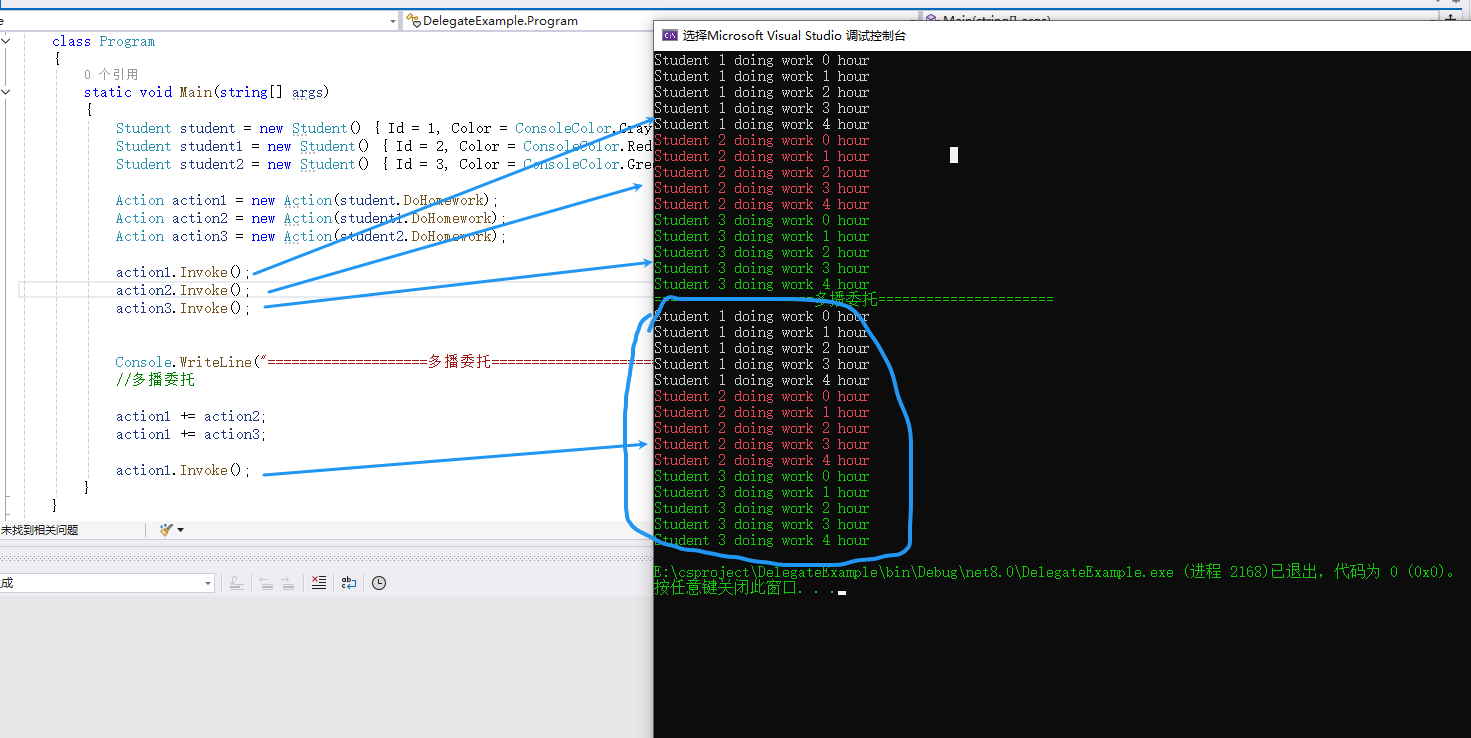
4.2隐式异步调用
1. 同步与异步的简介
- 中英文的语言差异
- 同步:你做完了我(在你的基础上)接着做
- 异步:咱们两个同时做(相当于汉语中的“同步进行”)
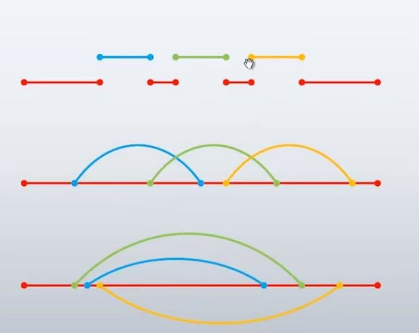
2.同步调用与异步调用的对比
- 每一个运行的程序是一个进程(process)
- 每个进程可以有一个或者多个线程(thread )
- 同步调用是在同一线程内异步调用的底层机理是多线程。
- 串行同步单线程,并行异步多线程
3. 隐式多线程 vs 显式多线程
- 直接同步调用:使用方法名
- 间接同步调用:使用单播/多播委托的Invoke方法
namespace DelegateExample
{
public delegate int Calc(int x, int y);
class Program
{
static void Main(string[] args)
{
Student student = new Student() { Id = 1, Color = ConsoleColor.Gray
};
Student student1 = new Student() { Id = 2, Color = ConsoleColor.Red
};
Student student2 = new Student() { Id = 3, Color = ConsoleColor.Green
};
//直接调用
student.DoHomework();
student1.DoHomework();
student2.DoHomework();
//单播委托间接调用
Action action1 = new Action(student.DoHomework);
Action action2 = new Action(student1.DoHomework);
Action action3 = new Action(student2.DoHomework);
action1.Invoke();
action2.Invoke();
action3.Invoke();
//多播委托间接调用
action1 += action2;
action1 += action3;
action1.Invoke();
for (int i = 0; i <
10; i++) {
Console.ForegroundColor = ConsoleColor.Cyan;
Console.WriteLine("Main thread {0}", i);
}
}
}
class Student
{
public int Id {
get;
set;
}
public ConsoleColor Color {
get;
set;
}
public void DoHomework()
{
for (int i = 0; i <
5; i++)
{
Console.ForegroundColor = this.Color;
Console.WriteLine("Student {0} doing work {1} hour", this.Id, i);
}
}
}
}打印结果均相同
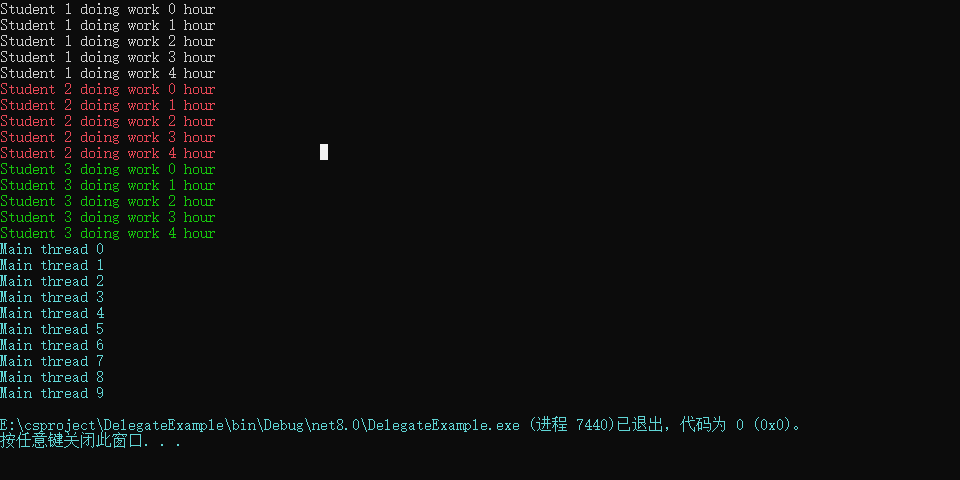
- 隐式异步调用:使用委托的BeginInvoke
namespace DelegateExample
{
public delegate int Calc(int x, int y);
class Program
{
static void Main(string[] args)
{
Student student = new Student() { Id = 1, Color = ConsoleColor.Gray
};
Student student1 = new Student() { Id = 2, Color = ConsoleColor.Red
};
Student student2 = new Student() { Id = 3, Color = ConsoleColor.Green
};
Action action1 = new Action(student.DoHomework);
Action action2 = new Action(student1.DoHomework);
Action action3 = new Action(student2.DoHomework);
//.NET 5 及更高版本Action.BeginInvoke 受到了限制
action1.BeginInvoke(null, null);
action2.BeginInvoke(null, null);
action3.BeginInvoke(null, null);
for (int i = 0; i <
10; i++) {
Console.ForegroundColor = ConsoleColor.Cyan;
Console.WriteLine("Main thread {0}", i);
}
}
}
class Student
{
public int Id {
get;
set;
}
public ConsoleColor Color {
get;
set;
}
public void DoHomework()
{
for (int i = 0; i <
5; i++)
{
Console.ForegroundColor = this.Color;
Console.WriteLine("Student {0} doing work {1} hour", this.Id, i);
}
}
}
}- 显式导步调用:使用Thread
using System.Threading;
namespace DelegateExample
{
public delegate int Calc(int x, int y);
class Program
{
static void Main(string[] args)
{
Student student = new Student() { Id = 1, Color = ConsoleColor.Gray
};
Student student1 = new Student() { Id = 2, Color = ConsoleColor.Red
};
Student student2 = new Student() { Id = 3, Color = ConsoleColor.Green
};
Thread thread1 = new Thread(new ThreadStart(student.DoHomework));
Thread thread2 = new Thread(new ThreadStart(student1.DoHomework));
Thread thread3 = new Thread(new ThreadStart(student2.DoHomework));
thread1.Start();
thread2.Start();
thread3.Start();
for (int i = 0; i <
10; i++)
{
Console.ForegroundColor = ConsoleColor.Cyan;
Console.WriteLine("Main thread {0}", i);
}
}
}
class Student
{
public int Id {
get;
set;
}
public ConsoleColor Color {
get;
set;
}
public void DoHomework()
{
for (int i = 0; i <
5; i++)
{
Console.ForegroundColor = this.Color;
Console.WriteLine("Student {0} doing work {1} hour", this.Id, i);
}
}
}
}打印结果:异步调用
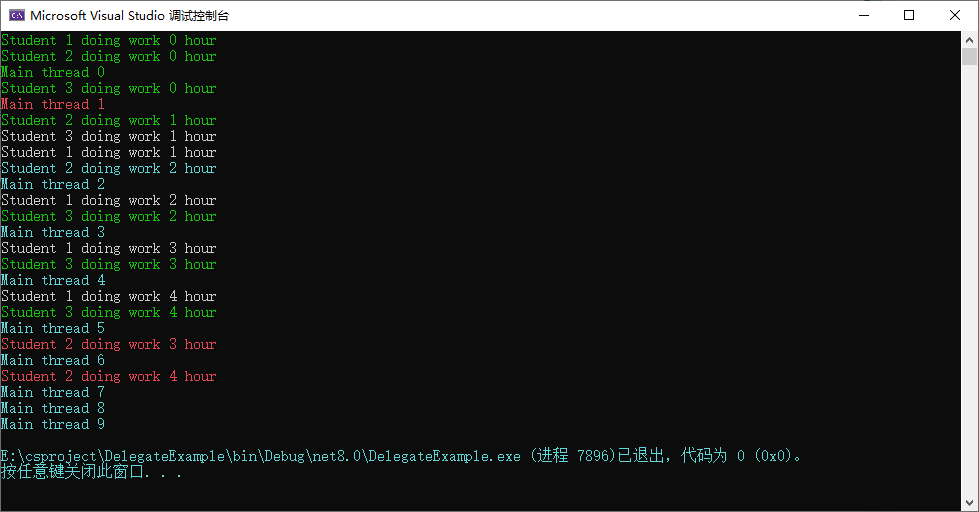
- Task 异步调用
using System.Threading;
using System.Threading.Tasks;
namespace DelegateExample
{
public delegate int Calc(int x, int y);
class Program
{
static void Main(string[] args)
{
Student student = new Student() { Id = 1, Color = ConsoleColor.Gray
};
Student student1 = new Student() { Id = 2, Color = ConsoleColor.Red
};
Student student2 = new Student() { Id = 3, Color = ConsoleColor.Green
};
Task task1 = new Task(student.DoHomework);
Task task2 = new Task(student1.DoHomework);
Task task3 = new Task(student2.DoHomework);
task1.Start();
task2.Start();
task3.Start();
for (int i = 0; i <
10; i++)
{
Console.ForegroundColor = ConsoleColor.Cyan;
Console.WriteLine("Main thread {0}", i);
}
}
}
class Student
{
public int Id {
get;
set;
}
public ConsoleColor Color {
get;
set;
}
public void DoHomework()
{
for (int i = 0; i <
5; i++)
{
Console.ForegroundColor = this.Color;
Console.WriteLine("Student {0} doing work {1} hour", this.Id, i);
}
}
}
}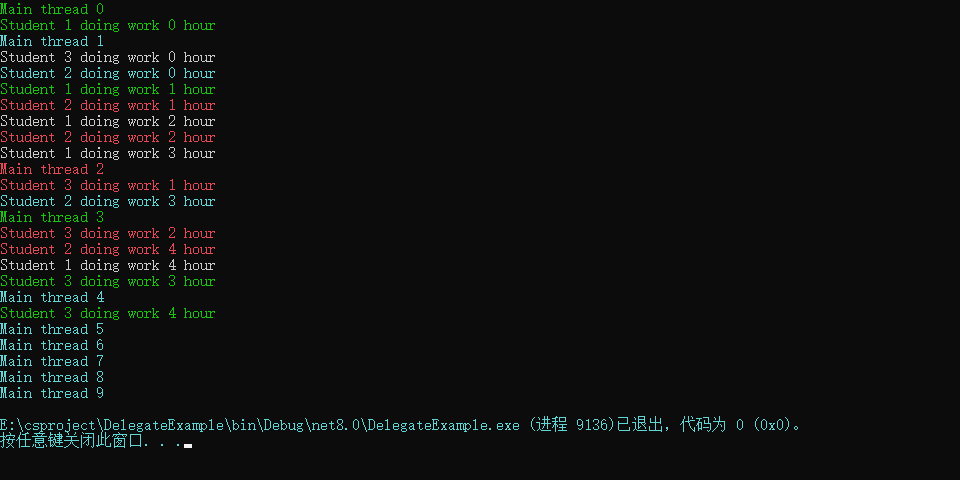





 浙公网安备 33010602011771号
浙公网安备 33010602011771号